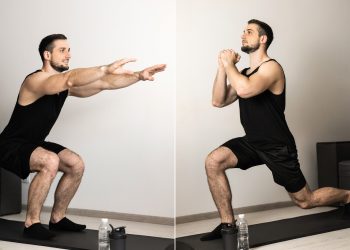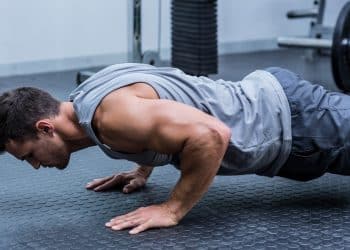The push-up (or press-up for our British readers) is the most popular and widely performed exercise on the planet. Almost everyone who works out has done push-ups. They’re used by recreational exercisers, Olympic athletes, and the military and often feature in high school PT classes.
The great thing about push-ups is that you can do them anywhere and anytime. They’re the perfect excuse-free workout. Pump out a set of push-ups whenever you’ve got a few minutes to spare, such as during TV ad breaks, or make them the cornerstone of your calisthenic upper body workouts.
But there is a downside to push-ups too. Because you are working with your body weight for resistance, the most convenient way to make them harder is to do more reps. As 20 becomes 30, and 30 becomes 50, your push-up workouts can become long and boring.
Yes, you can wear a weighted vest or raise your feet, but then you need more equipment, and some of the convenience of push-ups is lost.
Pike push-ups are more challenging than regular push-ups and provide a great way to elevate your push-up game. We reveal why and how to do this fantastic bodyweight upper-body exercise.
Pike Push-Ups – Muscles Worked
Pike push-ups are classed as a compound exercise because they involve multiple joints and train several muscles at the same time. The main muscles trained during pike push-ups are:
Level Up Your Fitness: Join our 💪 strong community in Fitness Volt Newsletter. Get daily inspiration, expert-backed workouts, nutrition tips, the latest in strength sports, and the support you need to reach your goals. Subscribe for free!

Deltoids
Known as the delts for short, these are your primary shoulder muscles. There are three deltoid muscles or heads: anterior (front), medial (middle), and posterior (rear). All three heads are involved in pike push-ups, but the anterior deltoid is the most active.
Triceps brachii
Located on the back of your upper arm, your triceps brachii is responsible for elbow extension. Pike push-ups put more weight on your arms than regular push-ups. As such, the triceps are heavily involved in pike push-ups and work as synergist or helper muscle.
Upper trapezius
The traps are a large diamond-shaped upper back muscle. There are three sets of fibers, each of which has a different function. The lower traps depress your shoulder girdle, the middle traps retract the shoulder girdle, and the upper traps elevate your shoulder girdle. All three sets of trap fibers are active during pike push-ups, but the upper traps are the most active.
Core
Core is the collective term for the muscles that encircle your midsection. Getting into and maintaining a pike position requires and develops a strong core. Your core stabilizes your spine so that your body remains rigid but flexed during your pike push-up workout.
How to Do Pike Push-Ups
Get more from pike push-ups while keeping your risk of injury to a minimum by following these guidelines:
- Adopt the push-up position with your hands roughly shoulder-width apart. Brace your core and pull your shoulders down and back.
- Keeping your legs straight, lift your butt into the air so your body resembles an inverted V.
- Move your hands closer to your feet to put more weight on your hands and achieve a more inverted position.
- Keeping your hips up, bend your arms and lower your head to within an inch of the floor. Tuck your elbows inward as you descend.
- Push back up until your arms are straight, and repeat.
Tips:
- Experiment with placing your hands more or less than shoulder-width apart to see which you prefer.
- Spread your fingers to create a more stable base from which to work.
- Actively engage your abs to maintain a strong piked position.
- Keep your neck neutral with your chin slightly tucked. Do not lift your head and hyperextend your neck.
- Place a folded mat on the floor below your head and touch it lightly to make sure you do each rep with the same range of motion.
Pike Push-Ups Benefits and Drawbacks
Not sure if pike push-ups deserve a place in your workouts. Take a look at these benefits and then decide!
An effective bodyweight deltoid exercise
Popular bodyweight upper body exercises like push-ups and dips primarily work your pecs. The deltoids ARE involved, but mostly in a synergistic role. Pike push-ups promote your deltoids to a starring role and are a great way to build bigger shoulders with just your body weight.
Build stronger triceps
Pike push-ups put more weight on your arms than regular push-ups. As such, they’re a useful exercise for building stronger, more muscular triceps, which is the muscle on the back of your arms.
Anywhere, anytime
You don’t need any equipment and very little space to perform pike push-ups. As such, they’re ideal for home exercisers, travelers, and anyone who wants or needs a no-frills upper body workout that’s still very effective.
Scalable
Somewhat surprisingly, there are several pike push-up variations you can use to make this exercise harder. Therefore, they’re suitable for all levels of trainee, including very advanced.
While pike push-ups are a mostly beneficial exercise, there are also a few drawbacks to consider:
They require good flexibility
Getting into and maintaining a solid pike position requires excellent hamstring flexibility. If your hammies are tight, you may not be able to get into the right position to do pike push-ups correctly or comfortably.
Maybe too advanced for some exercisers
You need to be able to do regular push-ups correctly before attempting pike push-ups. If you are a push-up beginner, pike push-ups may be too challenging for you right now. But the good news is that there are several exercises you can do instead, all of which are detailed below.
7 Pike Push-Up Variations and Alternatives
Pike push-ups are a highly effective upper-body exercise, but that doesn’t mean you need to do them all the time. There are several variations and alternatives you can use to keep your workouts productive and interesting:
1. Deficit pike push-ups
When you do pike push-ups, your range of motion is limited by the floor. You can’t go any further down than where your head touches the deck. With deficit pike push-ups, you place your hands on a raised surface so you can descend lower. This makes the exercise considerably more demanding and is an excellent progression for more advanced exercisers.
Steps:
- Place two dumbbells, yoga blocks, push-up handles, or parallettes on the floor about shoulder-width apart.
- Put your hands on your risers and adopt the push-up position. Brace your core and pull your shoulders down and back.
- Keeping your legs straight, lift your butt into the air so your body resembles an inverted V.
- Move your feet closer to your hands to put more weight on your arms and achieve a more inverted position.
- Keeping your hips up, bend your arms, and lower your head between your hands. Tuck your elbows inward as you descend.
- Push back up until your arms are straight, and repeat.
Muscles targeted:
- Primary: Deltoids, triceps.
- Secondary: Trapezius, core.
Benefits:
- A more demanding exercise than regular pike push-ups.
- An effective progression for more experienced exercisers.
- Greater range of motion at the shoulder joint for increases in mobility.
Tips:
- Start with a small deficit and increase your range of motion as you get used to the exercise.
- Experiment with different grip widths to see which you find most comfortable and productive.
- Make sure your chosen deficit won’t slip; otherwise, you could end up smacking your head into the floor.
2. Decline pike push-ups
This variation puts a lot more weight on your arms and is far more strenuous than the standard variation. Decline pike push-ups are best left to strong, experienced exercisers who have mastered regular pike push-ups.
Steps:
- Stand with your back to a knee-high bench. Put your hands on the floor and your feet on the bench. Lift your hips up toward the ceiling so your arms and legs are straight, and your body forms an inverted V shape.
- Keeping your hips up, bend your arms, and lower your head between your hands. Tuck your elbows inward as you descend.
- Push back up until your arms are straight, and repeat.
Muscles targeted:
- Primary: Deltoids, triceps.
- Secondary: Trapezius, core.
Benefits:
- A much more challenging exercise than regular pike push-ups.
- A good progression toward handstand push-ups.
- Much more weight on your arms, so a good exercise for building stronger, more muscular triceps.
Tips:
- Combine this technique with deficit pike push-ups for an even more demanding workout.
- Stretch your hamstrings before doing this exercise to get into a better pike position.
- The higher you lift your butt, the more demanding this exercise becomes, so position your hips accordingly.
3. Ring pike push-ups
Gymnastic rings and suspension trainers add a whole new dimension to bodyweight training. You’ll need to work extra hard to stabilize your limbs, which increases muscle and core engagement and makes your chosen exercise considerably harder. In addition, using rings or a suspension trainer means you can move through a larger range of motion, adding even more difficulty to your workouts.
Steps:
- Adjust your rings/suspension trainer, so your hands are 6 to 12-inches above the floor. Grab the handles and adopt the push-up position with your arms and legs straight. The straps should be vertical.
- Lift your hips and get into a pike position. Brace your abs.
- Bend your arms and lower your head down between your hands. Control the handles, and don’t let them swing away.
- Extend your arms and repeat.
Muscles targeted:
- Primary: Deltoids, triceps.
- Secondary: Trapezius, core.
Benefits:
- A VERY challenging pike push-up variation.
- Good for building stable, stronger, more muscular shoulders.
- A demanding core exercise.
Tips:
- Make this exercise easier by shortening the support straps. Longer straps move more and take more effort to control.
- Raise your feet to do decline gymnastic ring pike push-ups; they’re a killer!
- Use chalk on your hands to get a better grip on the rings. This is especially important if you are using plastic rings.
4. Handstand push-ups
If you’ve been working on pike push-ups for a while, you should be ready to progress to handstand push-ups. With this variation, you’ll be lifting your entire body weight with just your arms and shoulders. Make no mistake, this is a HARD exercise, but it’s also one of the best for building massive delts with just your body weight.
Steps:
- Squat down and place your hands flat on the floor, about shoulder-width apart. Your fingers should be pointing forward. Put a cushion between your hands for safety if you think you need one. Your hands should be about 12 inches away from the wall.
- Starting with one foot forward and one foot back, kick up and into a handstand so your feet are resting against the wall. Brace your core and get your balance. Keep your legs straight.
- When you feel stable, bend your arms and lower your head down to lightly touch the floor.
- Extend your arms and push yourself back up.
- On completion, lower your legs back to the floor and stand up.
- Take a moment to check your balance; it’s not uncommon to feel a little dizzy after doing this exercise.
Muscles targeted:
Level Up Your Fitness: Join our 💪 strong community in Fitness Volt Newsletter. Get daily inspiration, expert-backed workouts, nutrition tips, the latest in strength sports, and the support you need to reach your goals. Subscribe for free!
- Primary: Deltoids, triceps.
- Secondary: Trapezius, core.
Benefits:
- The most intense bodyweight shoulder exercise.
- An excellent exercise for improving balance and agility.
- A very effective triceps builder.
Tips:
- Take off your shoes; the last thing you want is to make this exercise harder by wearing shoes that create extra friction against the wall.
- Find a smooth wall to do your push-ups against. Make sure there are no pictures or other obstructions.
- Raise your hands on yoga blocks or push-up handles to increase your range of motion.
5. Shoulder press machine
If pike push-ups are a little too challenging for you right now, give machine shoulder presses a try. The weight is guided on rods, so you are free to focus on pushing your arms up and overhead to strengthen your triceps and deltoids. In time, you’ll develop the strength required to do pike push-ups.
Steps:
- Sit on the machine and grab the handles. Use an overhand or palms facing forward grip. Some machines also have parallel grips.
- Brace your core and pull your shoulders down and back.
- Keeping your wrists straight, extend your arms and push the handles up until your elbows are straight but not locked.
- Pause for 1-2 seconds, and then slowly lower the handles back to your shoulders and repeat.
Muscles targeted:
- Primary: Deltoids, triceps.
- Secondary: Trapezius.
Benefits:
- A safe and effective exercise for beginners.
- An excellent exercise for muscle-building drop sets.
- A very accessible movement – most gyms have a shoulder press machine.
Tips:
- Adjust the seat height so the handles are roughly level with your shoulders at the start of each rep.
- Do not let the weight touch down between reps, as doing so takes tension off the target muscles.
- Use the shoulder press machine at your gym according to the manufacturer’s instructions.
6. Resistance band overhead presses
You don’t have to go to the gym to train your shoulders. Armed with a simple resistance band, you can have a great workout anywhere and anytime. Resistance band exercises are also very joint-friendly.
Steps:
- Stand in the middle of your band and hold an end in each hand. Brace your abs and pull your shoulders down and back. Bend your knees slightly for balance.
- Raise your hands to shoulder height, palms facing forward.
- Extend your arms and push your hands up above your head.
- Lower your hands back to your shoulders and repeat.
Muscles targeted:
- Primary: Deltoids, triceps.
- Secondary: Trapezius.
Benefits:
- A portable exercise that you can do anywhere and anytime.
- A very joint-friendly exercise.
- No danger of dropping weights on your head, so no spotter is required.
Tips:
- This exercise works best when done for moderate to high reps – feel the burn!
- Sit down to lengthen the band and make your workout easier.
- You can also do this exercise using one arm at a time, i.e., an alternating arm action.
7. Dumbbell overhead presses
Pike push-ups are the bodyweight equivalent of this popular freeweight exercise. Most gyms have plenty of dumbbells, and adjustable dumbbell sets are perfect for home use. As an added advantage, you can use as little or as much weight as you want for this exercise, so it’s suitable for all levels, from complete beginners to super-advanced.
Steps:
- Stand with your feet about shoulder-width apart, knees slightly bent. Raise your dumbbells to shoulder height, palms facing forward. Pull your shoulders down and back, and brace your core.
- Keeping your wrists straight, extend your arms and push the dumbbells up, so they come together above your head.
- Lower the dumbbells back down to your shoulders and repeat.
Muscles targeted:
- Primary: Deltoids, triceps.
- Secondary: Trapezius.
Benefits:
- A good exercise for beginner, intermediate, and advanced exercises.
- An accessible exercise as most gyms have dumbbells.
- It can be used to develop muscle size or strength depending on the weight used and the number of reps performed.
Tips:
- You can also do this exercise seated instead of standing.
- Use a spotter if you plan on training to failure.
- Try alternating dumbbell overhead presses for variety.
Pike Push-Up Upper Body Workout
Pike push-ups are a great exercise, but you’ll get more from them if you incorporate them into a balanced upper-body workout.
Here’s a bodyweight-only pike push-up workout to try. Do it 1-2 times per week to build a strong, muscular upper body.
But before you begin, make sure you spend a few minutes warming up to prepare your muscles and joints for what you are about to do. Start with 5-10 minutes of cardio followed by dynamic mobility and flexibility exercises for your shoulders, arms, and lower back.
Read more about warming up for strength training here.
| # | Exercise | Sets | Reps | Recovery |
| 1 | Pike push-up | 4 | AMRAP – As Many Reps as Possible | 60 seconds |
| 2 | Pull-up | 4 | 60 seconds | |
| 3 | Deficit push-up | 3 | 60 seconds | |
| 4 | Australian pull-up | 3 | 60 seconds | |
| 5 | Diamond push-up | 2 | 60 seconds | |
| 6 | Close grip chin-up | 2 | 60 seconds |
Pike Push-Up FAQs
Got a question about pike push-ups? We’ve got the answers to the most common queries and concerns about this awesome bodyweight upper-body exercise!
1. What is the difference between pike push-ups and regular push-ups?
That’s a good question! Regular push-ups, where your body is mostly horizontal, put a lot of tension on your pectoralis major or chest muscles. Pike push-ups involve your deltoids or shoulder muscles more and provide very little work for your chest.
2. How often can I do pike push-ups?
You can probably do pike push-ups 2-3 times per week. However, to allow your muscles to recover, avoid doing pike push-ups on consecutive days. Instead, consider doing them every other day, e.g., Monday, Wednesday, and Friday. After all, your muscles do most of their growing when you rest.
3. How many reps of pike push-ups should I do?
This is one of those questions that’s impossible to answer. For example, some people may be able to do 15-20+ pike push-ups, whereas others might only be able to do 3-5. So, just do as many reps as you can in good form.
As you get stronger, your rep count will naturally increase. 2-4 sets of pike push-ups taken to this level of intensity 2-3 times a week should provide noticeable increases in strength and muscle size.
4. How do I know I’m ready to progress to a more difficult pike push-up variation?
If you can do a few sets of ten or more reps with good form, you are probably ready to move up a level and try a more demanding pike push-up variation.
However, if the next variation feels too overly hard, or you cannot do it properly, it’s okay to return to your previous level and focus on building up your rep count before trying to progress again.
5. Do I have to do pike push-ups?
No exercise is compulsory, and that includes pike push-ups. They’re a great exercise, but they’re not for everyone. So, try pike push-ups, but if you can’t do them or don’t like them, feel free to do a different exercise for your shoulders and triceps.
6. Can I use push-up handles for pike push-ups?
You most definitely can! In fact, using push-up handles may make pike push-ups more comfortable for your wrists. They also let you lower your head down between your hands, increasing your range of motion and providing a more demanding workout. So, push-up handles? Use ’em if you’ve got ‘em!
7. Which is better – pike push-ups or overhead presses with weights?
Both exercises have benefits and drawbacks so, invariably, the best one is whatever suits you best. Pike push-ups are the ideal choice if you train at home or prefer to work out without equipment.
But, if you want to lift progressively heavier weights or find pike push-ups uncomfortable, then overhead presses with weights are the winner.
Try both exercises if you can and see which works best for you.
Pike Push-Ups – Wrapping Up
Push-ups are awesome, and pretty much everyone who works out should do them as part of their upper-body workouts. But that doesn’t mean you are limited to doing the same type of push-up each time you train. In fact, there are lots of different push-up variations to choose from.
Pike push-ups put more weight on your arms and emphasize your deltoids. They’re the bodyweight equivalent of overhead presses.
Use them instead of freeweight or machine overhead presses or alongside more conventional shoulder exercises – the choice is yours. Regardless of how or when you do pike push-ups, your reward will be stronger, more muscular shoulders and triceps.
Interested in measuring your progress? Check out our strength standards for Push Ups, Machine Shoulder Press, Shoulder Press, and more.











